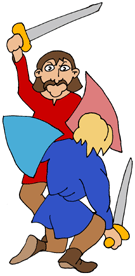|
RBH Home
Maps & Travels
Articles
Legends
Towns & Villages
Castles & Houses
Churches
Biographies
Gentry
Family History
Odds & Ends
For Kids
Teacher's Page
Mail David

|
|

A Place of Murder, Monastic Life
& Massacres

|
- There may have been an Iron Age hillfort
in the Northumberland Avenue area of Reading. Later, there was
probably a small Roman village with a ford across the River Kennet.
The ‘Read’ part of Reading may come from the Celtic word ‘Rhydd’
which means ‘ford’.
- Reading became a proper small town in
Saxon times. The name could mean ‘Reada’s People’ after the
followers of a Saxon leader named Reada who settled here. It was a
popular place for trading as it was easy to get to along the River
Kennet.
- In AD 870, the Vikings
invaded England. They set up their headquarters at Reading. The
Ealdorman of Berkshire put them under a siege, but they would
not move. Later King Alfred beat them.
- In AD 979, the English Queen-Mother,
Elfrith, murdered her 16-year-old step-son, King Edward, so that
her own son, Ethelred, could become King instead. Ethelred was so
upset that he set up a nunnery in Reading so that the nuns could pray
for forgiveness. This is now St. Mary’s
Church. The
dagger that stabbed the young King was kept as a holy relic on Caversham
Bridge.
- In Norman times, King William the
Conqueror wanted to know how wealthy his kingdom was. In 1086, he sent
clerks round the country and they recorded what they found in the ‘Domesday
Book’. Reading and Wallingford were the biggest towns in Berkshire.
Reading had a Royal mint for making money.
- In 1121, King Henry I had a monastery
built in Reading, with a huge abbey church. He was buried there while
it was still being built. It used to stand in the Forbury Gardens. Its
ruins can still be seen there today. The Abbot, who was in charge,
became very powerful in the town.
- In 1163, King Henry II came to Reading to
watch a 'Trial by Combat' on an island in the Thames. Henry of Essex had
been accused of cowardice. So Robert De Montfort fought him with sword and
shield. Essex lost and this was seen as proof of his guilt!
- In Medieval and Tudor
times, Reading
became famous for making cloth. Sheep were farmed on the Berkshire
Downs and their wool was brought to Reading. Merchants became very
rich by turning this into cloth and selling it in Flanders.
- The Pope was in charge of all the
churches. In the 1530s, King Henry VIII had a big argument with the
Pope because he wouldn’t let him get divorced from Catherine
of Aragon. King Henry set up his
own church, but the monasteries would not accept him as their new
leader. So the King ‘dissolved’ the monasteries, including Reading
Abbey. The monks were sent away, the buildings knocked down and the
stone and timber sold off.
- Reading was still a famous cloth
manufacturing town. A merchant called William Laud was rich enough to
send his son to Reading School and then to Oxford University. He
eventually became the Archbishop of Canterbury. Another merchant,
called John Kendrick, set up the original ‘Oracle’ where poor
people were given jobs working with cloth.
- During the English Civil War, between
King Charles I and Parliament, Reading Council could not decide who to
support. At first they were for Parliament. Then the Royalists arrived
and they decided they liked them instead.
- Big banks and ditches were dug around the
town and 3,000 Royalist soldiers were sent there to protect it from
attack. In 1643, the Earl of Essex and his Parliamentarian army
besieged Reading for 10 days. The town was forced to surrender.
- In 1688, Parliament took the Crown of
England away from King James II because he was a Roman Catholic.
Instead, they offered it to his nephew, William III, at Hungerford.
William marched to London to force James to leave the country. Their
armies fought in Reading, at the Battle of Broad
Street, and King
William won. This was the only fighting that took place during the ‘Glorious
Revolution’.
- In the 19th century, Reading became
famous for new industries: Beer, Biscuits and Bulbs! William Blackall
Simonds started brewing Hop Leaf Beer in 1785. Simonds’ Brewery was
eventually bought by Courage. Joseph Huntley started making biscuits
in 1811. This became Huntley and Palmers Biscuits. Sutton Seeds was
established in the town in 1807.
|
|



